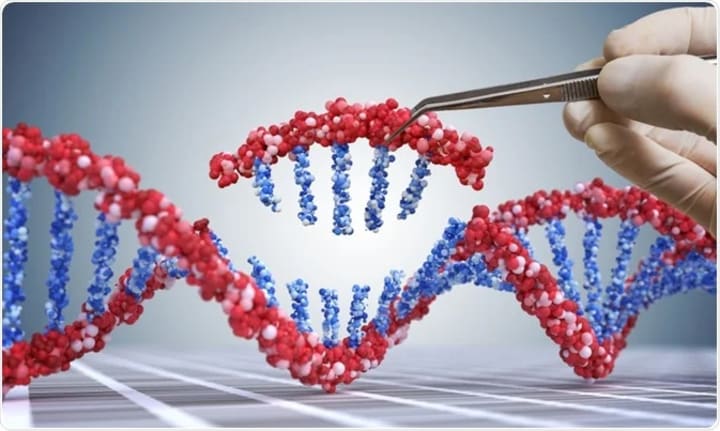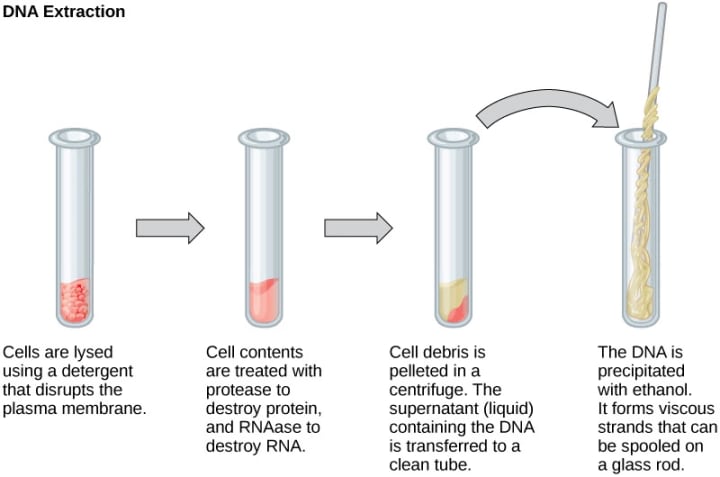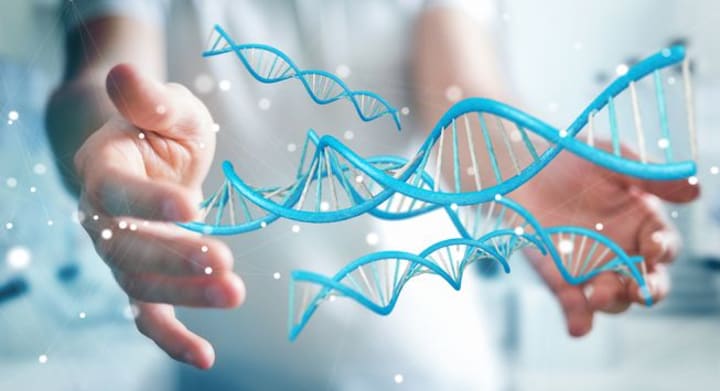Basic On Molecular Genetics- Mutation and DNA Isolation and Purification In Animal Cells (Part 3).
DNA PURIFICATION.

Introduction
Since we have understood what DNA, Genes, and CRISPR are, let us understand what mutation is and the various methods employed by molecular geneticists to isolate and purify DNA from an organism of interest; we will be considering animals, plants, bacteria and how their genetic materials are extracted in the laboratory; isolating and purifying DNA is the first step molecular geneticists employed before editing a gene of interest.
What is Genetic Mutation?

Genetic Mutation is defined as the rearrangement of the normal order of base pairs in the genetic makeup of an organism; this can be as a result of external factors after birth, during the developmental stages of a fetus, and can also be inherited. It should be noted that not all genetic mutations lead to a disorder; some genetic mutations improve the quality of an organism.
THERE ARE TWO MAIN TYPES OF GENETIC MUTATIONS

1. Germline Mutation
In this type of mutation, mutated genes are passed on from parents' reproductive cells to their offspring(s); when a parent has a genetic disorder that can be inherited via his/her sex cell, the resulting offspring may have the disorder- this type of mutation is inherited.
2. Somatic Mutation
For somatic mutation, genetic disorders are not passed on from parents' sex cells to their offspring during fertilization; the genetic material of the developing embryo undergoes mutation during the process of its development. Most genes found within an organism develop into proteins that perform specific functions; genes contain DNAs and DNAs are made of base pairs. If there is a mismatch in base pairs of DNA within a gene of a developing embryo, the resulting embryo will have a genetic mutation if mismatched base pairs are not corrected during proofreading.
DNA ISOLATION AND PURIFICATION

When a gene of interest is identified and needs to be modified, the DNA that makes up that gene has to be isolated and purified before it can be modified; the process requires laboratory work, various tools, and enzymes. Let us consider DNA isolation and purification in animals, plants, and bacterials.
DNA ISOLATION AND PURIFICATION IN ANIMALS

Two methods are involved in DNA isolation and purification in animals; they are enzymatic and chemical methods.
1. Enzymatic method
Animals' cells are protected by a protein called collagens; to disrupt the cell membrane of animal cells, the enzyme collagenases or trypsins are used; to isolate and purify a DNA of interest from an animal cell, the enzyme collagenases is used to disrupt the collagen fibers- which is a protein- in the cell membrane of the cell. The steps involved are listed below:
- The animal's cell of interest is placed in a test tube containing the enzyme collagenases and other constituents; collagenases disrupt the cell membrane of the cell releasing its genetic materials.
- Proteinase K is added to the cell extract together with phenol; proteinase K breaks peptide bonds holding amino acids within the protein.
- The cell extract is mixed with phenol and centrifuged for some time in the test tube; the main function of phenol is to coagulate the protein (mainly histone proteins) component of the cell. Protein components together with phenol settle at the bottom of the test tube; DNA and RNA components are collected on top in an aqueous solution. Phenol removes some RNA components of the mixture; in this process, DNA and RNA are collected together.
- To separate RNA from the DNA component, ribonuclease is added to the solution; RNAs are degraded by the cleaving of phosphorus-oxygen bonds.
- Silica-coated magnetic beads together with guanidinium thiocyanate are dropped into the solution containing DNA and RNA components; the positive charge of the silica beads binds with the negative charge of DNAs. The main function of guanidinium thiocyanate is to facilitate the binding of DNA to the coated magnetic silica beads.
- A magnet is used to collect the magnetic silica-coated beads together with the DNA.
- Silica-coated beads with DNA are placed in an aqueous solution in another test tube; NaCl is added, and the salt concentration causes the disassociation of the DNA from the silica-coated beads by inactivating guanidinium thiocyanate.
- The beads are collected leaving pure DNA molecules behind.
2. Chemical Methods

In this method, the chemical Sodium Dodecyl Sulphate (SDS), EDTA, Phenol, and Ribonuclease are used during the process; below are the steps involved.
- SDS is a solid anionic detergent that binds to the negative chargeed cell membrane and nuclear envelope disrupting them thereby releasing chromosomes with genetic materials; SDS stops the activities of most DNase maintaining the structure of the DNA.
- SDS also breaks peptide bonds between amino acids in a protein denaturing the protein; DNA is then released into the buffer solution.
- DNA is pH sensitive; to prevent it from denaturing, a tris buffer is added to maintain the pH of the solution.
- EDTA is an agent that prevents DNA from denaturing by blocking the activities of DNase; most enzyme requires a coenzyme to function, by blocking the coenzyme of most DNase, EDTA prevents DNA from denaturing.
- Phenol is added to the buffer and mixed; protein, together with phenol, is collected at the bottom of the test tube, and DNA and RNA are collected at the top of the test tube in an aqueous solution.
- RNase breaks RNA molecules into separate units.
- Silica-coated magnetic beads with guanidinium thiocyanate are dropped into the solution containing DNA and RNA components; the positive charge of the silica beads binds with the negative charge of DNAs. Guanidinium thiocyanate facilitates the binding of DNA molecules to the magnetic silica beads.
- A magnet is used to collect the magnetic silica-coated beads together with the DNA.
- Silica-coated beads with DNA are placed in an aqueous solution in another test tube; NaCl is added, and the salt concentration causes the disassociation of the DNA from the silica-coated beads by inactivating guanidinium thiocyanate.
- Magnetic silica beads are collected by using a magnet to attract the beads at the bottom of the test tube.

Written By: SEKOU SESAY.
ADVERTISEMENT SECTION BELOW:













- The beads are collected leaving pure DNA molecules behind.
About the Creator
Sekou Sesay
Love






Comments
There are no comments for this story
Be the first to respond and start the conversation.